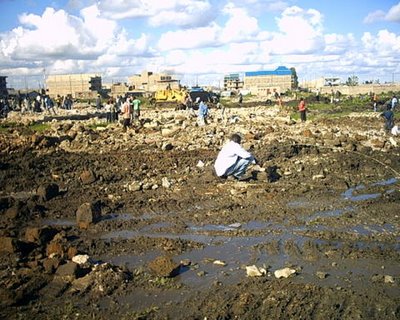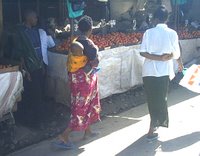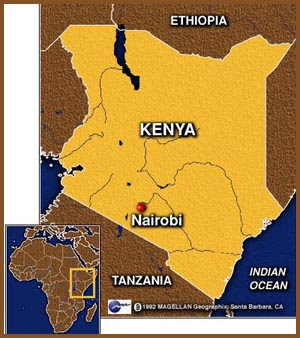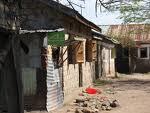:::::::::::::::::::::::::::::::::::::::::::::::::::::::::::::::::::::::::::::::::::::::::::::::::::::
Haiku Clubs’ Outing to St Patrick’s Church Kayole
***** Location: Nairobi, Kenya
***** Season: Hot dry season (3 April 2007)
***** Category: Humanity
*****************************
St Patrick’s Outing
Co-authored by Isabelle Prondzynski (in plain font) and Anthony Njoroge (in italics)
All photos © Isabelle Prondzynski unless otherwise mentioned.
More can be seen here in the album !
On 3 April 2007, the long awaited day for the Outing of the Haiku Clubs of Nairobi had arrived -- and a fine day it was, even while we were waiting for the rains to begin.
The venue was a surprise to many. We had been hoping to organise an excursion into a new venue in Nairobi City Centre, but technical problems had made this impossible. So, the community leaders of Tujisaidie Self-Help Project under the Urban Development Programme (UDP) of All Saints’ Cathedral had approached St Patrick’s Church in Kayole and requested the use of their tented hall for the day. The Haiku Club Patrons, who visited the venue on 31 March, found it to be excellent -- which indeed it proved to be on the big day.
The day is Tuesday, the 3 April. It is again another great day for the Kenya Haiku Clubs. It is a day that has been in every heart of the members. The new haijin in particular cannot hide their eagerness to be in their very first all club members' meeting and their very first ginkoo.
The first to arrive were the adults responsible for the day, who organised themselves, their papers and the hall, and then settled down to enjoy a chat and to wait.
There were Ms Louise Wambui Githire and Ms Kathleen Anangwe Warambo of the UDP, Ms Lucy Irungu of the UDP and Tujisaidie, and the Patrons, Patrick Wafula Sensei (Bamboochas and Co-ordinator), Madame Anne Nechesa and Madame Mercy (Peacocks), Mr David Kimani (Computer Teacher) and Mr Anthony Njoroge (responsible for haiku outreach to the wider community and Master of Ceremonies for the day).
The meeting was supposed to start at eleven. By that time few had made it to the venue.
eleven o’clock
anxious faces
long waiting
calm moments
gazing at the fence
prayerfully
Just some few minutes past time, the Butterflies came in, followed by the Peacocks and then the Baboochas.
brightened faces
Isabelle dashes
at last
shaking hands
smiling haijin
the crowd stranded
Butterflies
Peacocks Bamboochas
march in
Soon, the haijin had signed the list, and the hall had filled with chatting friends, glad to be together again. Anthony Njoroge (my co-author here and also the Master of Ceremonies for the day), greeted the haijin and the Patrons and visitors and encouraged the eager participants to begin the day well, by singing a few favourite choruses.

Singing choruses to start us off
Our host for the day, Revd Charles Kimani, joined us to welcome everyone and say a few words of encouragement to the students, which were very well received.
Then...
reverend
supplication
eyes closed
The Patrons one by one greeted the gathering, telling of the progress of the individual clubs.
speaking out
delighted hearts
reflecting
I reported on recent successes of Kenya Saijiki -- the publication of our haiga in haigaonline (December 2006), the success of the stars and night sky challenge, the contribution of our haiku to a planned book on peace related haiku, and the reading of one of our haiku on a radio show in Ireland :
corruption is daily --
you must pay cash
today
~ Christine Nyakado and Jacinta Minoo (Peacocks), 2006
The haijin were delighted to hear that we are now among the foremost haijin in Africa and able to participate as such in many haiku fora.
Computer certificates
Revd Charles Kimani had mentioned examinations... And indeed, our first agenda item was to applaud the students who had passed their final computer examinations after a year of study, both theoretical and practical, and to award certificates and prizes to them.
Mr David Kimani, the computer teacher, was greeted with cheers and applause.
The students who were presented with beautiful certificates and individual prizes, were the following :
1. Catherine Njeri Maina (Bamboocha)
2. David Caleb Mutua (Peacock)
3. Raymond Otieno (Bamboocha)
4. Walter Otieno (Bamboocha)
5. Gladys Kathini (Peacock)
6. Jacinta Minoo (Peacock)
7. Cyprian Awino (Bamboocha)
8. Gideon Gichamba Wangui (Peacock)
9. John Mwangi (Bamboocha)
10. Nyakado Christine (Peacock)
11. Khadija Rajab (Peacock)
12. Simon Magak (Bamboocha)
13. Dorine Atieno (Peacock)
applauses
certificates awarded
prizes in hardy
All 47 haijin who had completed the computer course were in addition presented with haiku notebooks and encouraged to make good use of their new skills!

The computer graduates with their certificates
Stars and Night Sky Challenge
The next item, eagerly awaited by all, was the announcement of the winners of the Stars and Night Sky Challenge, and the presentation of prizes for some spectacularly beautiful haiku. I was very proud that we are now able to assemble such a splendid collection!
winners announced
night stars goes on
end marked
The report on this Challenge, together with the photos of the happy prizewinners, both student and adult, can be found here :
stars-and-night-sky
Ms Louise Wambui Githire, the Co-ordinator of the Urban Development Programme of All Saints’ Cathedral, then brought bottled water for everyone, and smiles of relief could be seen all round the sun-heated tent.
dry lips
water cans provided
lighting faces
After a short discussion, the sun had passed the central point and the shadow was now moving west.
withered faces
empty stomachs
hard going
Anthony Njoroge reminded the students that it was still Lent, and that many Christians were fasting at this time. David Kimani’s remark, raising his water bottle : “You have now had your lunch!” brought the house down!
Fortunately, Louise had brought bread and milk in plenty, and soon, there was satisfied chatter all over the hall.
milk and bread
hunger defeated
life restored
As the Falcons and the Oaks had been prevented by exam schedules from participating in the outing, there was a glut of bread, milk and biscuits -- a glut that did not last for long!
April Ginkoo
It was soon back to activity -- the eagerly awaited ginkoo. As we had a large number of new Form One students with us, who were trying a ginkoo for the first time, the rules on this occasion were quite specific :
- the first word of each haiku is the month, i.e. April
- the second word is an important characteristic of the time, for instance :
~ sun
~ dust
~ clouds
~ wind
~ heat
- the second and third lines will contain an observation
- the students were asked to find a place and write all their haiku in that same place
- each student would write up to ten haiku
- each haiku would start with the same two words (April + ...)
- students would preferably write individually, not in groups
- haiku were not to be written about other haijin
- each would hand in the best two haiku, unsigned, but for the club name
The students then dispersed around the compound and soon, all were concentrating here and there, observing, and consulting the adults as they circulated among the students, offering words of advice and sharing in a smile or a laugh here and there.

Patrick Wafula sensei joining the students
The compound proved to be a good place. The natural beauty and the artistic make up provided a great setting for the ginkoo. After a short briefing on what was expected: -
moving out
pens and papers
nature focused
eyes opened
confined at a point
all in ones
april
under microscope
no escape
After handing in the ginkoo haiku, the judges took their time to evaluate and come out with the best of the best. The winners were announced in the midst of a jovial session.

The prize winners of the April Ginkoo
Alan Summers, our Stars and Night Sky judge, gave us great pleasure by adding his comments (see below each haiku).
HAIKU
1.
---
April sun --
dry clothes swing and swing
on the line
~ David Caleb Mutua (Peacock)
A haiku full of movement and capturing the breeze without even needing to mention it by name.
2.
---
April wind --
girl's long hair
blowing upwards
~ Anne Wairimu (Bamboocha)
Lovely, I can imagine it in my mind straightaway!
3.
---
April sun
slowly vanishing --
a thick cloud taking over
~ Paul Wandera (Bamboocha)
Captures the changes in the sky wonderfully!
4.
---
April wind --
the leaves dancing
to beats of Eshikuti
* Eshikuti is one type of Luhya traditional music
~ Esther Keyombe (Peacock)
Fantastic blend of breeze and musical beats!
5.
---
April sun --
a cock and hen resting
under a hedge
~ Catherine Njeri Maina (Bamboocha)
A very beautiful haiku, full of plain language, and making it universal.
6.
---
April dust --
handkerchief covered with mucus
cursing the month
~ Dorine Atieno (Peacock)
A very good haiku capturing part of a season, and not afraid to include 'mucus'. The great poet Shiki would have appreciated this haiku!
7.
---
April sun --
the brown grass leaves
crunching under my feet
~ Vivian Adhiambo (Bamboocha)
Excellent, a haiku full of sound and texture!
8.
---
April wind --
sand whirls spirally
papers go up
~ Cyprian Awino (Bamboocha)
We have all shared the nightmare of papers being blown about by the wind, thank you for the universal image.
9.
---
April wind --
itinerant traders
with dust on their goods
~ Teresiah Wanjiku (Bamboocha)
Wonderfully evocative! It just goes to show that there is no need for lots of complicated words to evoke a strong image.
10.
----
April sun --
the sound of dry grass
under my feet
~ Jane Njeri (Bamboocha)
Both Vivian and Jane's haiku remind me of a favourite one of mine, which the BBC liked so much they filmed me making a live version!
11.
----
April sun --
sweat running down my
dusty face
~ Sarah Adero (Bamboocha)
Very imagistic. I can also feel the heat, and sensation of the heat.
12.
----
April dust --
ants struggling to scuttle
through the dusty sand
~ John Mwangi (Bamboocha)
I love your alliteration with "struggling" and "scuttle" and "sand"! This is very difficult to do and make a successful haiku and you have done it, well done!
13.
----
April sun --
a car under a shade
for cool seats
~ Gideon Gichamba (Peacock)
Simple yet very provative, and it brings back hundreds of memories. A very good haiku!

The UDP car with Kathleen, Louise and Lucy
Photo © David Kimani Mwangi
14.
----
April wind
gives a must-dance to
the trees
~ George Ombima (Peacock)
Very original, and quite brilliant, well done!!!
15.
----
April wind --
cloths flapping on
the hangline
~ Caren Cheptoo (Bamboocha)
I like your use of a different word other than clothesline. Your choice of 'hangline' also gives extra layers of meaning. Another excellent haiku.
The jury then read out the haiku and the authors came forward to huge applause, to collect their prizes. Special congratulations went to brand new haijin Esther Keyombe (no. 5 prizewinner), whose first ever haiku had done so well!
Thanks and prayer
I congratulated all on a wonderful day spent together, and indicated that our next meeting would take place in August -- something for all of us to look forweard to! Meanwhile, a new challenge was set -- haiku about animals, to be written between now and then, with prize winners to be selected in time for that event.
After a word of prayer and vote of thanks all left at their own pleasure.
come come
longing for you
oh august

Sweet memories of all those observations!
Photo © David Kimani Mwangi
*****************************
Related words
***** Stars and Night Sky Challenge
***** The Haiku Clubs of Nairobi
***** Meeting of the Haiku Clubs in Tujisaidie, 4 November 2006
***** Bahati Ginkoo, 27 May 2006
*****************************
THE KENYA SAIJIKI
Please send your contributions to
Gabi Greve / Isabelle Prondzynski
worldkigo .....
Back to the Worldkigo Index
















